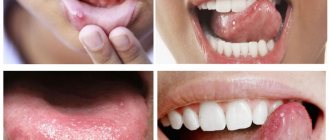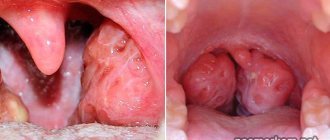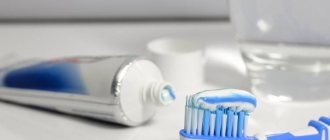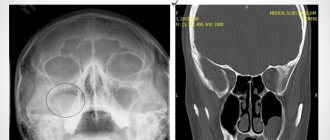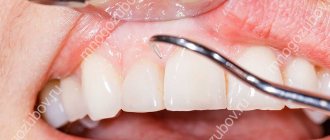Facial swelling is not only a cosmetic defect; if it appears frequently or is accompanied by redness and pain, it is a sign of quite serious health problems that need to be identified and treated.
ALENA PARETSKAYA
Pathophysiologist, immunologist, member of the St. Petersburg Society of Pathophysiologists ANDREY GRACHEV Leading cardiologist of the SM-Clinic holding, MD, academician of the Russian Academy of Medical Sciences
Facial edema is not a separate disease, but only a reflection of an imbalance between retention and excretion of fluid in the body. But what problems in the body can cause the face to swell and how serious is it?
Causes
Know! The amount of fat under the skin in the cheekbone area increases over the years, but a number of predisposing factors can accelerate the process of formation of sufas, including:
- sudden weight gain in general;
- genetic predisposition;
- the formation of constant swelling, as a result of which the skin stretches and the subcutaneous space filled with fat increases.
Painting bags can visually increase due to sagging skin , which with age .
Main indications and contraindications for surgery
There are no medical indications for surgery. Girls who are dissatisfied with their appearance often sign up for it: with chubby cheeks, unexpressed cheekbones and an unclear oval face. Age-related changes, which manifest themselves in the form of prolapse of soft tissues, are also encouraged to sign up for the procedure. Sometimes the operation is performed in combination with other procedures, for example, lipofilling. Many Hollywood stars have undergone plastic surgery for Bisha's lumps (before and after photos).
Popular actresses include Jennifer Aniston and Demi Moore.
It is not always possible to perform surgery to remove a fatty lump from the cheek. There are a number of temporary, relative and absolute contraindications. These include:
- blood diseases (leukemia, bleeding disorders);
- malignant neoplasms (regardless of location);
- acute infectious pathologies;
- serious mental disorders (schizophrenia, depressive disorders);
- severe pathologies of internal organs;
- young age (up to 25 years);
- inflammatory diseases of the oral cavity;
- disorders of the endocrine system (for example, diabetes);
- pregnancy and lactation period.
Prevention
It is impossible to prevent the development of sufs.
This is because these fat deposits inevitably appear with age.
But you can slow down degenerative processes by following these preventive recommendations :
- the diet should be balanced : it should include more foods containing vitamin B;
- for normal functioning of the hormonal system and to prevent the formation of bags from overwork, it is necessary to get enough sleep , allocating 7-8 hours a day for sleep;
- stable physical activity has a tonic and , which can be achieved by walking in the fresh air for only half an hour a day;
- You need to drink 1.5-2 liters of water per day to maintain water-salt balance.
Remember! For sensitive skin predisposed to the development of such cosmetic defects, nourishing and moisturizing face creams should be used.
When choosing them, it is better to consult a cosmetologist.
Is there swelling on the face due to heart disease?
Yes, these questions usually worry women, says cardiologist Andrei Grachev.
They run to see a cardiologist when they can’t put a ring on their finger in the morning because it’s swollen or put on makeup because their face is swollen. The patient wants to look great, regardless of age and health status. And this is commendable. Men, as a rule, do not contact a cardiologist with such questions. The peculiarity of this issue is due to the fact that in patients with cardiovascular diseases, as a rule, swelling on the face appears at the final stage of a complication such as heart failure. First, they appear on the legs (the lowest point in relation to the heart), then fluid accumulates in the abdominal cavity, the liver and spleen enlarge (as a blood depot). And only after the fluid reaches the pleural cavities and the heart sac, swelling may occur on the face or hands.
Reviews about the treatment
“
Bags on my cheekbones appeared for the first time several years ago . No cosmetic products helped. The salon advised me not to spend money on creams and suggested doing a facelift .But we were warned in advance that this is not a 100% guarantee of permanently getting rid of the bags, and additional operations may be required over the years.
I agreed, as a result, the bags were almost completely removed, and although more than two years have passed, my face looks almost the same as after the procedure .”
Elizaveta Shipnevskaya, Kislovodsk.
“When I started having sufs , at first I didn’t attach any importance to it, attributing everything to age.
But over the years, my face began to look like the face of an alcoholic. It was unpleasant and ugly, and I decided to have a check-lift .
The procedure is not very expensive for me, but I am satisfied with the effect.
But the specialist warned even then that over time the bags would reappear, and then they would either have to do liposuction or consider the option of fillers.”
Marina Panyutina, 48 years old.
Why does the face swell in adults?
Swelling on the face can occur at different times of the day - mainly in the morning or late afternoon, or they persist throughout the day, decreasing or increasing.
There are two types of reasons:
- physiological (or natural, not associated with diseases), they are usually not pronounced, not very strong, and disappear quickly;
- pathological, can be very strong, with changes in facial features, signs of inflammation, and are often quite persistent.
Each type of edema has the most typical causes; they occur mainly in the morning or evening hours, or do not depend in any way on the time of day. These characteristics are important for the doctor so that he can identify the leading causes and determine the tactics of examination and treatment.
Why do bags form under the eyes?
The eyeball is naturally separated from the skin and muscles by layers of fat, which are most pronounced in the infraorbital area. There are also additional fat deposits in the zygomatic area and the area of the tear trough. If the tissues weaken, lose elasticity, become thinner, the intraorbital membrane experiences increased stress. The fat pads that they hold begin to move forward, and pouches form in the lower eyelid area. They put pressure on the blood and lymphatic capillaries, fluid retention occurs, and dark circles with swelling occur.
A similar process occurs in the area of the upper eyelid. It hangs over, causing discomfort, causing wrinkling of the forehead and the development of wrinkles.
Symptoms of TMJ arthrosis
Information about arthrosis of the temporomandibular joint on the Internet is 50% far-fetched descriptions of arthrosis of large joints, 30% is outdated data and obvious nonsense. And only 20% is true. Alas, texts are written by people without medical education, copying not from special educational literature or monographs, but from each other. Therefore, trust only trusted sources, and treat your health where there are no such ignorant things on the clinic websites.
First signs
A person may assume that he has arthrosis of the jaw when, after visiting doctors and following their recommendations, pain in the back of the head, ear, when chewing, hearing loss on one side, clicking, etc. does not go away.
Due to the structural features of the joint, the body manages to turn on the compensatory mechanism, so there is no long-term aching pain; due to the medications taken, it successfully disappears for a while.
Obvious symptoms
There are only 2 obvious symptoms (but it is also impossible to say 100% that this is arthrosis):
- displacement of the jaw to the side;
- pain when chewing.
You need to see a doctor immediately.
Removing bags under the eyes without surgery
The main problem of many patients is morning bags under the eyes. Tea compresses help eliminate them. Due to the influence of tannins and caffeine, they constrict blood vessels and increase the removal of fluid from tissues. Compresses with chamomile tea help remove signs of fatigue and eye irritation.
Cold spoons help to quickly cope with the problem. They eliminate swelling and redness by constricting blood vessels. Another quick and easy way to remove morning swelling is a cucumber mask. Two cool circles of cucumber placed on the eyes stimulate the capillaries to drain excess fluid.
You can wipe the skin around the eyes with cold milk, and then apply patches soaked in cold milk to the area under the eyes.
These same tips can be used regularly to eliminate dark circles, puffiness and bags under the eyes at home.
Massage, which is carried out according to strictly defined rules, can help combat the problem. You need to apply a little eye cream to the periorbital area, place your index fingers in the bridge of the nose, move them along the eyebrows, and then move down along the edges of the eye sockets, making light patting movements.
What else can you do to reduce the bags under your eyes? Use cosmetics. Together with a cosmetologist during a consultation, you need to select products that help reduce puffiness and dark circles.
Types of arthrosis of the temporomandibular joint
For treatment to be effective, it is important to understand that there are several types of arthrosis of the lower jaw.
Deforming arthrosis
Osteoarthritis of the TMJ usually develops after injury. The clinical course depends on the nature of growth and the location of osteophyte proliferation (towards soft tissues or the articular cavity). If bone growth is directed to soft tissues, the disease is asymptomatic for a long time. If the osteophyte grows into the cavity of the glenoid cavity, local acute pain appears, which occurs with limited jaw movement. Clicking and crunching are dull, and sometimes popping sounds appear.
The joint becomes deformed with the growth of the condyle, changes occur in the synovial membrane and are accompanied by hemorrhagic synovitis. The reason for this is irritation of the TMJ, caused by the multiple presence of dead and rejected cartilage cells (intra-articular detritus). The synovial villi on the inner lining of the joint enlarge and fat is deposited in them. Occasionally, they degenerate, forming islands of bone and cartilage tissue (metaplasia), which are separated from the articular surface and form intra-articular free bodies.
Please note: this is not salt, it is osteochondral tissue. Therefore, folk remedies for arthrosis, which can still help with gout, do not work.
Viral and infectious diseases during this period inflame the joint membrane, accelerating the destruction of cartilage and bone.
Facial asymmetry does not appear in all patients diagnosed with arthrosis deformans. This depends on the compensatory capabilities of the neuromuscular complex and on the functional grinding of the articular surfaces.
Sclerosing arthrosis
Not only vessels can be sclerotic. With arthrosis, the 2 upper layers of bone become sclerotic (bone tissue is replaced by dense connective tissue). In this case, some compaction of the head occurs, followed by expansion. Since replacement is a slow process, the body manages to compensate for the changes. Therefore, the disease goes unnoticed in the initial stages.
Neoarthrosis (post-infectious arthrosis of the TMJ)
The disease is a consequence of an acute inflammatory process in the TMJ, with repeated acute respiratory viral infections and with the presence of dysfunctional jaw syndrome (luxation, neuromuscular, occlusal-articulatory). It is asymptomatic. With exacerbation of chronic inflammation, the following is noted:
- dull, aching pain that intensifies when moving the jaw;
- crunch;
- clicking in the HFNS.
X-rays show usuria (disappearance of osteochondral tissue), defects in the articulating surfaces of bones, and sometimes the complete absence of condyles.
Myogenic arthrosis of the TMJ
In orthopedics, there is a separate type of deforming arthrosis of the TMJ, myogenic. Its difference: a beak-shaped bone growth on the anterior surface of the condyle.
X-ray shows myogenic arthrosis, the contours of the articular surface due to osteophyte resemble a bird
Myogenic arthrosis occurs due to prolonged spastic tension of the lateral (lateral) pterygoid muscle. Its middle bundles are attached to the anterior-inner surface of the condyle and its process. Prolonged muscle spasm leads to a lack of coordination of muscle contractions, the bone beams change direction, stretch, positioned along the direction of the tendon traction. If the spastic contraction of the muscle continues, the bones that form the joint will begin to break down.
Differences from other forms:
- the condyle always has a beak-like shape;
- bone growth (osteophyte) is always localized in a specific place;
- no restrictions on jaw movement;
- the disease occurs without facial asymmetry.
The initial stages of the disease are asymptomatic. The osteophyte grows gradually on the anterior surface of the condyle, does not rub against hard tissues, and forms a bed in soft tissues. In the joint area, nutrition is disrupted, there may be a slight swelling on the face, spider veins - but very often this is explained by fatigue, overload, without paying attention to the TMJ. Painful symptoms occur at the moment of dislocation, subluxation of the lower jaw. Since the movement of the jaw in such cases is atypical, the osteophyte injures the soft tissues, irritating the nerve endings - severe pain appears (it hurts to chew hard food), severe swelling, clicking, mild swelling and paleness of the skin flap (pastyness). At the moment the mouth opens, the jaw begins to shift to the side.
Metabolic arthrosis
This is a rare type of disease that occurs when salt metabolism in the body is disrupted. The reason is needle-shaped crystals of uric acid settling in the TMJ. In patients, large joints are first affected; they suffer for a long time from metabolic polyarthritis, the visual manifestation of which is “gouty bumps” on the joints.
Symptoms:
- significant deformation of the head of the lower jaw, detected by palpation;
- asynchronous movement of the condyles when opening and closing the mouth;
- hinge movements on the side of the diseased temporomandibular joint;
- crunch;
- local dull pain;
- when opening the mouth, the jaw moves to the side;
- Lateral position of the head leads to facial asymmetry.
On radiographs with metabolic arthrosis, the condyle is covered with whitish needle-shaped curls of various shapes that are not permeable to x-rays.
Crunching in joints - when to worry
Intra-articular injections of hyaluronic acid
Senile arthrosis of the TMJ
Senile, or invaliable, arthrosis occurs with age. “Aging” of cartilage tissue occurs in 3 stages:
- cartilage tissue becomes soft and loose;
- loses some of the water, dries out, becomes denser;
- The smooth surface disappears, the cartilage becomes fragile and becomes covered with cracks.
After 60 years, bone exposure begins. Patients feel uncomfortable chewing and clicks are noted in the TMJ. The x-ray shows subtle changes.
Frequently asked questions about the disease
Who treats arthrosis of the temporomandibular joint?
The treatment is complex. If there is no gnathologist in the medical institution, treatment is carried out by a surgeon or orthopedic traumatologist. In this case, a dentist, a neurologist, an otolaryngologist and, if necessary, a rheumatologist and an infectious disease specialist must be involved.
Is it possible to cure TMJ arthrosis?
If bone growths have begun, the process can be stopped, but it will not be possible to defeat the disease when the joint is young and healthy. But if you start treatment at least at stage 2 of the disease, you will be able to get rid of the symptoms, stop the destruction and even restore cartilage tissue.
Why is arthrosis of the TMJ dangerous?
Deformation in the joint leads to facial asymmetry, secondary inflammation spreads to the nasopharynx and ear. Due to spasmed muscles, teeth wear out and fall out. The skin on the face becomes pasty and ages quickly.
What is the difference between arthrosis and TMJ arthritis?
Arthritis is an inflammatory process in the temporomandibular joint of infectious-allergic, traumatic, autoimmune, etc. origin, which in advanced cases can lead to arthrosis. For example, a purulent infection (purulent otitis, boil in the ear canal, flu, sore throat, mumps, etc.) infects the joint fluid. The inflammatory process spreads to the joint capsule (the local temperature rises, the blood vessels of the heads of the bones grow and dilate). The purulent process then dissolves the cartilaginous surface and meniscus, and then destroys the bone tissue, leading to arthrosis. Arthrosis destroys the joint asymptomatically at the first stage and without an acute inflammatory process. The cartilage loses moisture, dries out, and cracks. The bone then grows, changing the structure of the joint.
Literature
- Evdokimenko P.V. Arthrosis
- Petrosov Yu. A., Kalpakyants O. Yu., Seferyan N. Yu. Diseases of the temporomandibular joint
Themes
Arthrosis, Joints, Pain, Treatment without surgery Date of publication: 10/08/2021 Date of update: 11/01/2021
Reader rating
Rating: 4.5 / 5 (2)
Advantages and disadvantages of surgery
Despite the fact that Bisha's lumps do not carry a functional load for an adult, not everyone supports the decision to remove them. Among the main arguments of opponents are the risk of negative consequences, low effectiveness in people with full faces, the visual addition of several years due to sunken cheeks, and the inability to return everything back if the result is not satisfactory. However, the technique is still in great demand because it has a number of advantages. These include:
- correction. By eliminating the fat cells under the cheekbones, it is possible to give the lower part of the face clarity and definition. This will create a rejuvenating effect;
- modeling. Often, people with small facial features have lumps of non-standard sizes, which disrupts the proportions of the face. With the help of surgical intervention, it is possible to carry out modeling and make the features more proportional;
- elimination of excess fat. Unlike the popular procedure - liposuction, a lasting effect is observed during bishectomy. The face after surgery looks more refined;
- safety of the technique. As practice shows, the likelihood of complications developing is minimized;
- eliminating signs of aging. When the cheeks sag, a person's overall facial features change. This leads to the appearance of deep skin folds. As a result of surgery, the skin is tightened and nasolabial wrinkles are eliminated;
- weight loss Even intense physical activity and exhausting diets are not always able to get rid of chubby cheeks. Thanks to bishectomy, a visible facial slimming effect is guaranteed.
